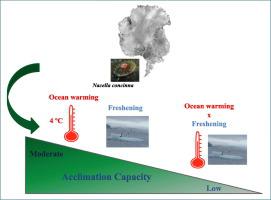Science of the Total Environment ( IF 9.8 ) Pub Date : 2020-09-22 , DOI: 10.1016/j.scitotenv.2020.142448 Jorge M. Navarro , Camille Détrée , Simon A. Morley , Leyla Cárdenas , Alejandro Ortiz , Luis Vargas-Chacoff , Kurt Paschke , Pablo Gallardo , Marie-Laure Guillemin , Claudio Gonzalez-Wevar

|
In the Southern Ocean, warming and freshening are expected to be prominent signals of climate change and the reduced ability of Antarctic marine organisms to cope with changing environmental conditions could challenge their future survival. The Antarctic limpet Nacella concinna is a macroinvertebrate of rocky ecosystems, which occurs in high densities in the shallow subtidal zone. Subtidal individuals were exposed to a combination of temperatures (1, 4, 8, 11, 14 °C) and salinities (20 and 30 psu) for a 60-day period. A drastic increment in mortality was observed with seawater warming, showing that N. concinna is highly stenothermal, with limited ability to survive at temperatures warmer than 4°C, although there was some degree of acclimation at 4 °C and ambient salinity (30 psu). This study confirmed the stenohaline characteristic of this species, with mortality reaching 50% and lower scope for growth at low salinity (20 psu) even at the control temperature (1°C). At the sub-cellular level, limpets’ low tolerance to out-of range salinity is illustrated by the activation of cell remodelling processes whereas the down-regulation of chaperones proteins and plasma membrane ATPase suggest that under the combination of warming and freshening N. concinna experiences a severe level of stress and devote much of its energy to somatic maintenance and survival. The drastic effect observed can be explained by its subtidal origin, an environment with more stable conditions. The surviving individuals at 1 °C and lowered salinity (20 psu) were either more tolerant or showing signs of acclimation after 60 days, but the combination of warming and freshening have a greater combined stress. Projections of climate change for end of the century for this part of the Antarctic can, therefore, result in a significant diminution of the subtidal population of N. concinna, affecting ecological interactions and diversity of the food web.
中文翻译:

评估海洋变暖和清新对南极帽贝Nacella concinna的生理能量和转录组反应的影响
在南大洋,变暖和变暖有望成为气候变化的重要信号,而南极海洋生物应对环境条件变化的能力下降可能会挑战其未来的生存。南极帽贝Nacella concinna是岩石生态系统的大型无脊椎动物,其发生在浅潮下带的高密度区域。潮下个体要经历60天的温度(1、4、8、11、14°C)和盐度(20和30 psu)的共同作用。随着海水变暖,死亡率急剧增加,这表明N. continna尽管在4°C和环境盐度(30 psu)下有一定程度的适应性,但它具有高度的狭窄热力,在高于4°C的温度下生存的能力有限。这项研究证实了该物种的甜茶碱特性,即使在控制温度(1°C)下,死亡率也达到50%,并且在低盐度(20 psu)下的生长范围较小。在亚细胞水平上,帽贝对盐度超出范围的低耐受性可以通过细胞重塑过程的激活来说明,而伴侣蛋白和质膜ATPase的下调表明在变暖和新鲜N.continna的结合下承受着严重的压力,并将其大部分精力用于身体的维持和生存。所观察到的剧烈影响可以通过潮下带来解释,潮间带是条件更稳定的环境。在1°C和盐度降低(20 psu)的情况下,存活的个体对60天后的耐受性更高或有适应的迹象,但变暖和变新鲜的组合具有更大的组合压力。因此,对本世纪末南极地区气候变化的预测可能会导致康尼猪笼草的潮下种群显着减少,从而影响生态相互作用和食物网的多样性。



























 京公网安备 11010802027423号
京公网安备 11010802027423号